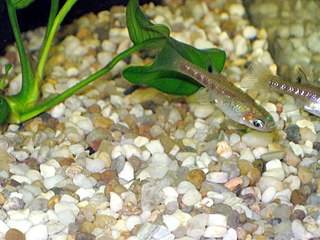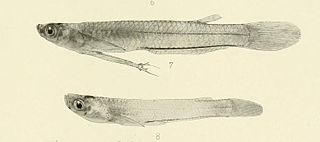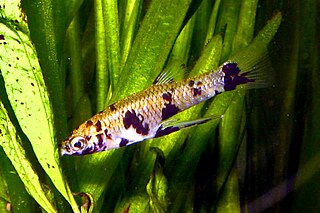
The Poeciliidae are a family of freshwater fishes of the order Cyprinodontiformes, the tooth-carps, and include well-known live-bearing aquarium fish, such as the guppy, molly, platy, and swordtail. The original distribution of the family was the Southeastern United States to north of Río de la Plata, Argentina, and Africa, including Madagascar. Due to release of aquarium specimens and the widespread use of species of the genera Poecilia and Gambusia for mosquito control, though, poeciliids can today be found in all tropical and subtropical areas of the world. In addition, Poecilia and Gambusia specimens have been identified in hot springs pools as far north as Banff, Alberta.

Gambusia is a large genus of viviparous fish in the family Poeciliidae. Gambusia contains over 40 species, most of which are principally found in freshwater habitats, though some species may also be found in brackish or saltwater habitats. The genus Gambusia comes from the Cuban term, "Gambusino", which means "free-lance miner". The type species is the Cuban gambusia, G. punctata. The greatest species richness is in Mexico, Texas, and the Greater Antilles, but species are also found elsewhere in the eastern and southern United States, the Bahamas, Central America, and Colombia. Gambusia species are often called topminnows, or simply gambusias; they are also known as mosquitofish, which, however, refers more specifically to two species, G. affinis and G. holbrooki, which are often introduced into ponds to eat mosquito larvae. As a consequence, they have been introduced widely outside their native range, and frequently become invasive, threatening local species. G. affinis and G. holbrooki are now established in many parts of the world and are likely to continue to spread as climatic conditions change. They are only occasionally kept in aquariums, due to their relative lack of color and the highly aggressive nature of the aforementioned mosquitofish species.

Poecilia is a genus of fishes in the family Poeciliidae of the order Cyprinodontiformes. These livebearers are native to fresh, brackish and salt water in the Americas, and some species in the genus are euryhaline. A few have adapted to living in waters that contain high levels of toxic hydrogen sulfide and a population of P. mexicana lives in caves.

Astyanax is a genus of freshwater fish in the family Characidae of the order Characiformes. Some of these fish, like many of their relatives, are kept as aquarium pets and known collectively as tetras. With around 150 described species and new ones being described yearly, this genus is among the largest of the entire order; Hyphessobrycon also has more than 145 species and which one is larger at any one time depends on whether more species have been recently described in one or the other. The blind and colorless cave tetra of Mexico is a famous member of the genus, but its taxonomic position is disputed: Some recognize it as part of the Mexican tetra and this is supported by phylogenetic evidence, but others recognize the cave form as a separate species, A. jordani.

Rainbowfishes are small, colourful freshwater fishes belonging to the family Melanotaeniidae, found in northern and eastern Australia, New Guinea, Sulawesi and Madagascar.

Glandulocaudinae are a subfamily of tropical freshwater characin fish from Central and South America. In all species of this subfamily, a gland on their caudal fin is found almost exclusively in the males, which allows the release and pumping of pheromones; also, members of this subfamily have complex courtship behaviors which lead to insemination. The ecology and life history of these fish is complex yet little studied. Glandulocaudines are important as food fish for larger fish important for commercial and subsistence reasons.

Goodeinae is a subfamily of splitfins from Mexico, part of the family Goodeidae. They are small fish which mostly live in fresh water, especially around Mesa Central, west of Mexico City. Members of the subfamily are also found in brackish water on both the east and west coasts. They typically have small ranges and many are seriously threatened. The subfamily takes its name from its type genus Goodea and so is ultimately named after the American ichthyologist George Brown Goode (1851-1896).

Anchoa is a genus of ray-finned fishes in the family Engraulidae. It currently consists of 35 species.

Brachyrhaphis is a genus of poeciliids native to freshwater habitats in Central America. Most are restricted to Panama and Costa Rica, but B. holdridgei also occurs in Nicaragua and B. hartwegi is from Mexico and Guatemala. A recent phylogenetic analysis has suggested that Brachyrhaphis may not be of a monophyletic group.
Carlhubbsia is a genus of poeciliids native to Guatemala and Mexico. The name of this genus honours the American ichthyologist Carl Leavitt Hubbs (1894-1979) who originally named the genus Allophallus, a name which was preoccupied by a genus of Diptera.

Girardinus is a genus of poeciliids native to Cuba. The name of this genus honours the French zoologist Charles Frédéric Girard (1822-1895) for his work on the freshwater fish of North America.
Priapichthys is a genus of poeciliid fishes native to Costa Rica, Panama and Colombia.

Tomeurus gracilis is a species of poeciliid fish native to South America, in Brazil, Surinam and Venezuela. This species grows to a length of 3.3 centimetres (1.3 in) TL. It is the only known member of its genus. This species is classified in the tribe Cnesterodontini in the 5th edition of Fishes of the World, but other workers place it in its own tribe, the Tomeurini.
Cynodonichthys is a genus of freshwater killifish in the family Rivulidae. They are found in Middle America, ranging from southern Mexico, through Central America, to Colombia. They are non-annual killifish and inhabit small forest streams from the lowlands to an altitude of 1,500 m (4,900 ft).

Gambusiini, also spelled Gambusini, is a tribe of killifishes from the "livebearer" family Poeciliidae. Their native range encompasses Central and much of North America, with a single species Gambusia lemaitrei occurring in South America. Some species have been widely introduced outside their native range and the Eastern mosquitofish Gambusia holbrooki is considered to be one of the 100 worst invasive species in the world and is responsible for declines in small native aquatic species worldwide.

The Heterandriini is a tribe of killifishes from the "livebearer" family Poeciliidae, consisting of seven genera and around 50 species. The tribe was originally delineated by Carl Leavitt Hubbs in 1924.

The Poeciliini is a tribe of killifishes from the "livebearer" family Poeciliidae, consisting of six genera and just over 100 species.

The Girardini is a tribe of killifishes from the "livebearer" family Poeciliidae, consisting of three genera and 10 species. The tribe was originally delineated by Carl Leavitt Hubbs in 1924.

Poecilia parae is a species of fish from the family Poeciliidae which is found in northern South America from Guyana to the mouth of the Amazon River.

Cnesterodontini is a tribe of fishes which are within the subfamily Poeciliinae of the family Poeciliidae. This tribe is distinguished from other tribes in the Poeciliinae by the males having five rays in the pelvic fin, there is a pedicle at the base of the third ray which joins it to the fourth ray, another pedicle at the third rays tip and a membrane there too.

















